How Yoga for Back Pain Can Help You Find Relief
The popular mind-body practice can also soothe an aching back
Medically reviewed by Amy Kwan, PT, DPT
Back pain affects more than 80% of people worldwide. Yoga stretches help decrease back pain for some people, though results are similar to the benefits of other types of exercise. Many yoga poses—such as cat-cow, downward-facing dog, and cobra pose—target the back, helping to relieve pain and increase flexibility.
This article discusses how yoga poses help relieve back pain, poses to try, and tips for keeping yourself safe.
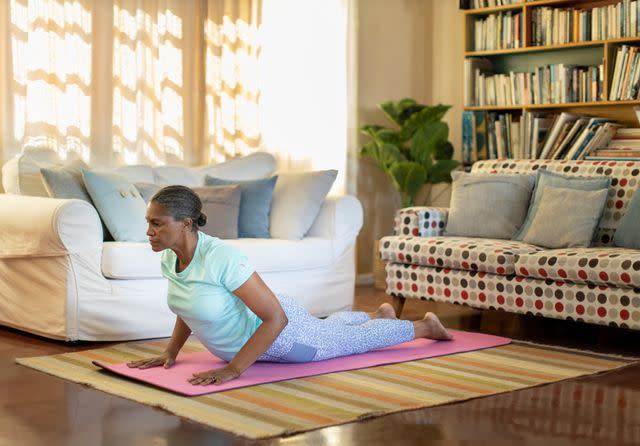
Alistair Berg / Getty Images
Why Yoga for Back Pain Is Beneficial
Yoga improves strength and flexibility. Strong back muscles are essential for supporting the spine and nerves in your back. In addition, yoga is a mind-body practice, which is why the benefits of yoga poses for back pain are more than just physical.
Benefits of yoga for back pain can include:
Better balance
Decreased stress and anxiety
Decreased symptoms of depression
Improved ability to breathe
Improved function with daily tasks
Improved strength
Increased flexibility
Stronger bones
Poses to Try for Back Pain
When trying poses for back pain, avoid any positions that exacerbate your symptoms. Move slowly and carefully to allow your muscles to gradually stretch into position to avoid further injury.
Cat-Cow
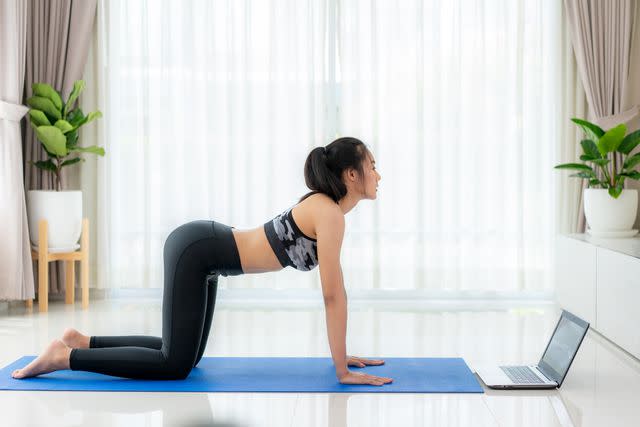
Prasit photo / Getty Images
The cat-cow pose improves back flexibility through flexion (forward bending) and extension (backward bending).
Begin on your hands and knees, with your hands in line with your shoulders and your knees in line with your hips.
Straighten your spine so that your back is flat. Inhale.
Exhale as you round your back upward and drop your chin down toward your chest.
Inhale and drop your belly toward the floor as you arch your back and lift your chest.
Repeat for several breaths.
Downward-Facing Dog
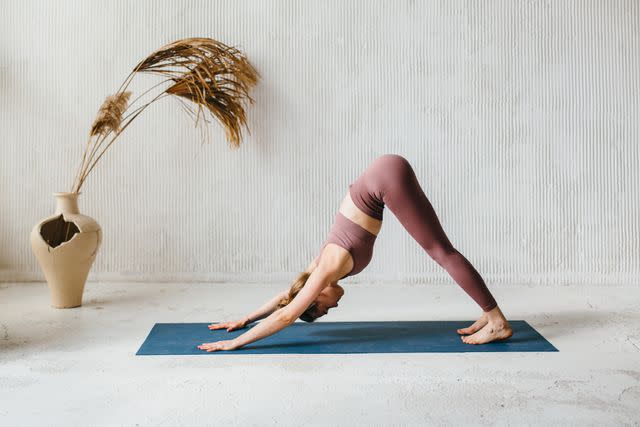
Tanja Ivanova / Getty Images
The downward-facing dog pose stretches your shoulders, legs, and back muscles.
Begin on your hands and knees, with your hands in line with your shoulders.
Raise your knees off the ground and walk your feet backward until your knees are straight. This is the starting position.
Keep your elbows, knees, and spine straight and lift your hips toward the ceiling. Press down through your hands and shift your weight backward. Keep your neck aligned with the rest of your spine—your ears will align with your shoulders. In this position, your body will form an inverted "V."
Hold this position for several breaths, then return to your starting position.
Triangle/Extended Triangle
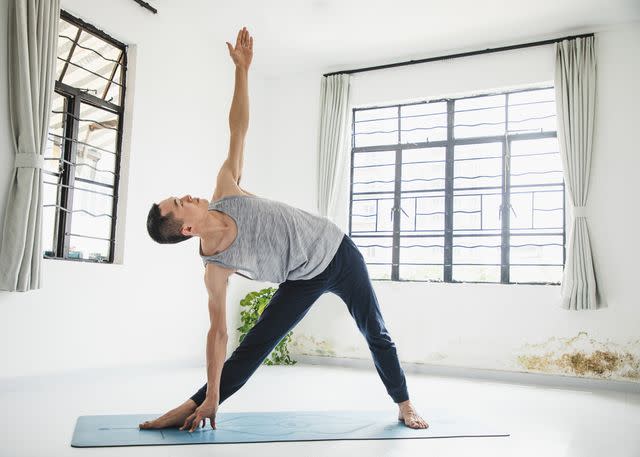
Kilito Chan / Getty Images
In addition to stretching your back muscles, the extended triangle pose improves your balance.
Stand with your feet wider than hip-width apart.
Rotate your right foot outward 90 degrees.
Inhale and lift your arms straight out to your sides, forming a "T" position.
Maintaining the "T" position with your arms, exhale and slowly bend sideways to the right. Reach your right hand down toward the inside of your right ankle. Stop when you feel a stretch along your left side. Your left arm should point toward the ceiling.
Rotate your head to the left and look up toward the ceiling.
If your bottom hand stops at your shin or ankle, you are performing the triangle pose. When you reach your big toe or place your hand on the floor next to your foot, you have assumed the extended triangle pose.
Sphinx Pose
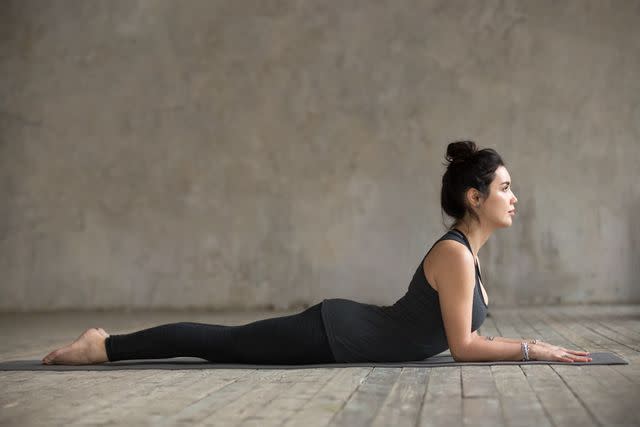
fizkes / Getty Images
The sphinx pose gently stretches your spine into extension.
Lie on your stomach on a firm surface with your legs together.
Bring your elbows underneath your shoulders and rest your forearms on the ground.
Keeping your hips and belly relaxed on the ground, inhale and slowly lift your chest and head into a gentle back bend.
Hold for several breaths, then return to your starting position.
Cobra Pose
The cobra pose is a more advanced back-bend pose. Progress to this pose only after you can perform the sphinx pose comfortably.
Lie on your stomach on a firm surface with your legs together.
Bring your elbows underneath your shoulders and rest your forearms on the ground.
Slowly straighten your elbows, lifting your chest into a back bend. Your hips should remain in contact with the ground.
Hold for several breaths and return to your starting position.
Locust Pose
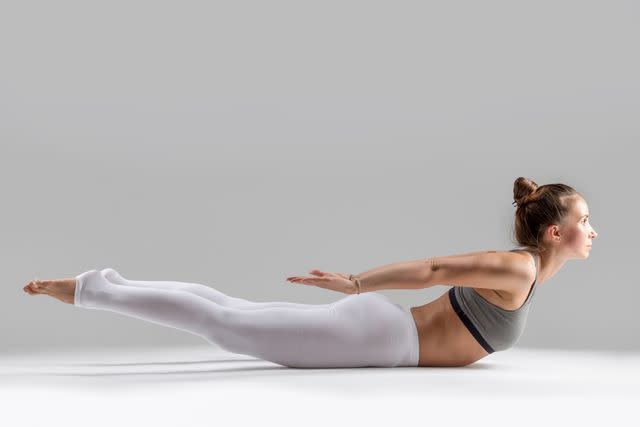
fizkes / Getty Images
The locust pose can help improve posture and decrease low back pain.
Lie on your stomach on a firm surface.
Rest your arms by your sides with your palms facing the ground.
Inhale and squeeze your shoulder blades together, lifting your chest, head, and arms into a gentle back bend. At the same time, press the tops of your feet into the ground and tighten your leg muscles so your knees lift slightly off the ground.
Hold for several breaths, then return to your starting position.
Bridge Pose
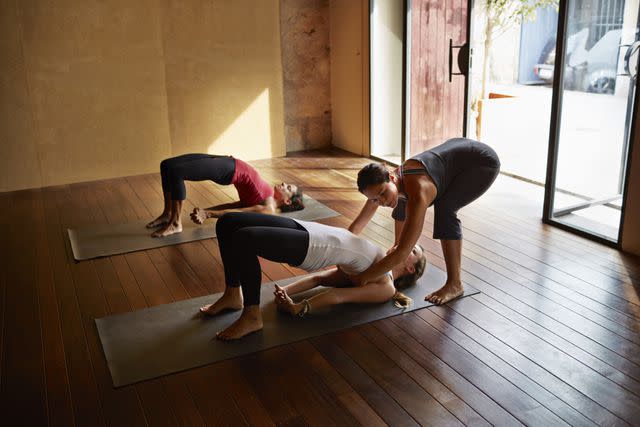
Klaus Vedfelt / Getty Images
The bridge pose incorporates extension for a gentle back bend stretch. This can serve as an alternative to sphinx or cobra pose if you have difficulty lying on your stomach.
Lie on your back on a firm surface.
Rest your arms by your sides, bend your knees, and place your feet flat on the floor.
Squeeze your buttocks together, tighten your ab muscles, and lift your hips off the ground. Your body should be straight, from your shoulders to your hips.
Hold for several breaths, then lower your hips to the ground.
Half Lord of the Fishes
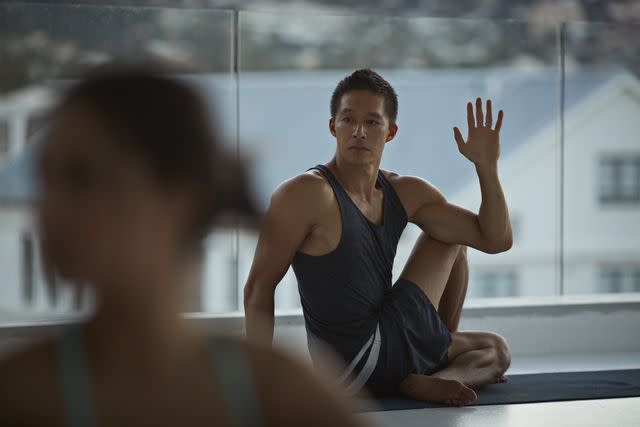
Klaus Vedfelt / Getty Images
The half lord of the fishes pose provides a rotating stretch, improving overall mobility.
Sit on a firm surface with your legs straight out in front of you.
Bend your right knee and cross it over your left leg.
Place your right foot flat on the ground outside your left knee.
Rotate your trunk to the right. Place your left elbow outside your right knee with your hand pointed toward the ceiling.
Place your right hand on the ground behind you and look over your right shoulder.
Hold for several breaths, then repeat on the opposite side.
Two-Knee Spinal Twist
The two-knee spinal twist—also called the abdominal twist—can help improve digestion and stretch your back muscles.
Lie on your back on a firm surface.
Bring your legs together, bend your knees, and place your feet flat on the floor.
Lift your knees toward your abdomen, pressing your lower back into the ground.
Rotate your knees to the right and slowly lower them toward the ground until you feel a stretch in your back.
Hold for several breaths.
Return to the center, then lower your knees to the opposite side.
Child's Pose
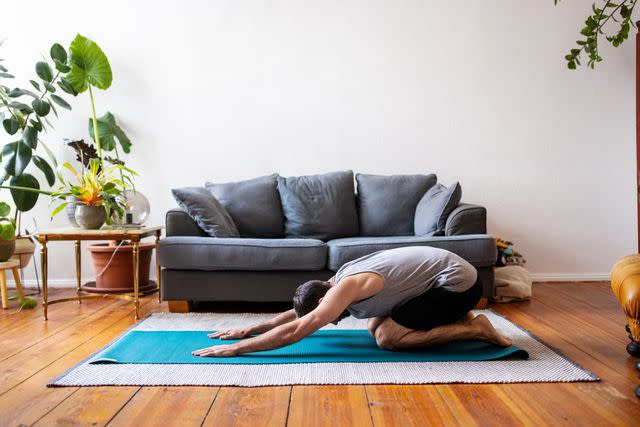
Luis Alvarez / Getty Images
Child's pose stretches your spine from your neck to your tailbone.
Kneel on a firm surface.
Spread your knees wider apart than your hips.
Raise your arms overhead and bend forward at your hips, resting your buttocks on your heels.
Rest your chest between your thighs and forehead on the ground.
Hold for several breaths.
Does Yoga for Back Pain Really Work?
Research has shown that yoga can help to reduce back pain symptoms. However, these results are similar to the effects of other types of exercise.
Talk to a Healthcare Provider
Back pain can indicate an underlying condition that needs medical treatment. To help prevent your symptoms from worsening, talk to a healthcare provider—such as a physical therapist—before trying yoga to relieve your back pain.
Seek immediate medical attention before attempting yoga if you have had back pain for more than a few weeks or you have the following signs or symptoms:
Chills
Fever
Loss of bowel or bladder control
Numbness or tingling in the arms and legs
Unexplained weight loss
Weakness
Tips for Protecting Yourself on the Mat
Avoid poses that increase your pain or other symptoms to avoid worsening your back pain while doing yoga. Consider working with a certified yoga instructor who can modify your poses to help keep you safe.
Summary
Yoga poses can help reduce back pain and improve strength and flexibility. However, research shows that the benefits of yoga for back pain are similar to those of other types of exercise. To avoid worsening your symptoms, consider working with a certified yoga instructor who can tailor poses to your needs. Talk to a healthcare provider before trying yoga for back pain.
Read the original article on Verywell Health.

